|
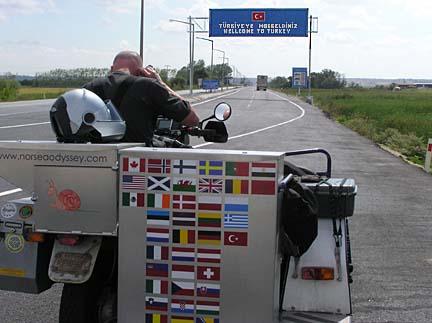 We began our journey in Turkey in the north, arriving from northern Greece in September, 2005. This northwestern corner of Turkey is part of the European continent, rather flat in contour, and few cities of notable mention. We drove toward Istanbul and by late afternoon (in the evening traffic rush) crossed the Bosphorus Straights and had arrived on the continent of Asia. We decided to pass through Istanbul for now, saving our visit there for the return journey. The photo above is just after we finished border formalities and added the Turkey flag. Jim is putting in his earplugs in preparation for our journey. We began our journey in Turkey in the north, arriving from northern Greece in September, 2005. This northwestern corner of Turkey is part of the European continent, rather flat in contour, and few cities of notable mention. We drove toward Istanbul and by late afternoon (in the evening traffic rush) crossed the Bosphorus Straights and had arrived on the continent of Asia. We decided to pass through Istanbul for now, saving our visit there for the return journey. The photo above is just after we finished border formalities and added the Turkey flag. Jim is putting in his earplugs in preparation for our journey.
Once past the bustle of Istanbul, we headed east then north toward the Black Sea. On the way, we made a stop at the lovely old Ottoman town of Safranbolu. Our tour book indicated that it was a favorite place for Turkish tourists, but relatively few foreigners stopped there. As expected, we were two of the very few foreigners there. Its claim to fame is the abundance of Ottoman houses (photo below left), some better preserved than others, as a few looked near to falling down.
However, many of them now serve as hotels and guesthouses. We checked out a few of them but most did not have parking facilities (at least level ones)so we ended up staying at Cinci Hana, a hotel converted from a caravansary dating back to 1645. It was very nicely done and still had the original small doorways you had to step over and duck into at the same time. For Jim, this was especially difficult (photo, above right). We spent several hours roaming around the town, seeing the various old houses and the many shops. Once known for its handicrafts, the town abounds with shops of handicrafts, but few craftsmen still practice there. There are also many sweets shops selling mounds and mounds of Turkish Delight. The local delicacy is a variety consisting of halva spotted with ground walnuts which, of course, we had to buy. It is very tasty and not too sweet. The information on it says it will last a long time and is great for traveling - sounds like the sweet for us!
Leaving Safranbolu we continued north to Amasra, a small coastal city on the Black Sea. East of here, the coast road winds around the coastal hills, providing varying scenes of the sea and the wooded inland. Very few towns are along this stretch, usually only where a river flows into the sea, providing fresh water for the residents. We stopped for the night at Cide, a small fishing village where we found a guest house for the night, just outside the town on a quiet bay (below left). Our first surprise upon stopping was being greeted by a young lady (the proprietress) wearing shorts and a sleeveless shirt. After getting us settled, she set to help her mother finish cleaning the bucket of fish that her father had just caught (which was of course to be that night’s meal). We took a walk toward town, enjoying the peacefulness and quiet. We met a German traveler staying at the same guesthouse and enjoyed a quiet meal with him, sharing stories of each other’s travels.
Inebolu was our next stop and we spent several days there waiting for parts to arrive for the bike. This was the largest town we had yet seen on the coast and it was quite a center of commerce for this neck of the woods. The commercial area of town was about 4 blocks by 6 blocks and seemed to have every conceivable item for everyday living (above right). We found 5 or 6 small markets, 4 internet cafes, various barbers, hardware shops, a bus station (with direct busses to Istanbul) and at least 4 mosques. As we were there for several days, we had the opportunity to wander around a bit and become familiar with pace of life. We were an oddity in town as not too many western tourists make it up here. And if Verna went walking alone through town in the mornings, she was the object of attention as usually we did not see women alone on the street until the afternoon. Everywhere we went, it seemed that the locals went out of their way to help us, even if neither of us spoke each other’s language.
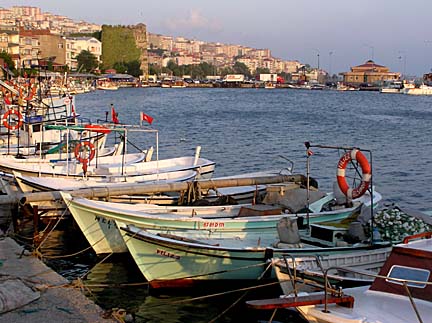 Continuing our journey along the Black Sea, we made a stop at Sinop, a port city since the 8th century. Enjoying our seaside lunch of bluefish and a salad, we decided to stay the night and wander a bit. Probably the most notable site is the ruins of the fortress walls that once protected the port (photo left, the structure covered with green ivy is the wall). Although extended over the centuries, the existing walls were originally developed in 72 BC. The waterside along the port is home to many fishing vessels and a significant portion is park like and supports many restaurants serving up the local fish. As we looked for a hotel, we carefully surveyed the surroundings, looking for the ubiquitous minaret of the local mosque (we learned by now to not stay in the hotel next to the mosque if you didn’t want the 5:30 am wake-up call). Not seeing one, we checked into a hotel that offered decent parking (on-street, but not a busy area). We got up to our room (not on the street-side) and opened the window to gaze out to the port and found, yes, the minaret right next door. Foiled again! However, in this day and age with the loudspeakers on the minarets, it really doesn’t matter how close or far you are, you are always within earshot. We also went shopping to find Jim a new T-shirt and found a store that specialized in seconds from the booming Turkish textile industry. For about $2 we got a great shirt whose only visible defect was an off-centered decal. Continuing our journey along the Black Sea, we made a stop at Sinop, a port city since the 8th century. Enjoying our seaside lunch of bluefish and a salad, we decided to stay the night and wander a bit. Probably the most notable site is the ruins of the fortress walls that once protected the port (photo left, the structure covered with green ivy is the wall). Although extended over the centuries, the existing walls were originally developed in 72 BC. The waterside along the port is home to many fishing vessels and a significant portion is park like and supports many restaurants serving up the local fish. As we looked for a hotel, we carefully surveyed the surroundings, looking for the ubiquitous minaret of the local mosque (we learned by now to not stay in the hotel next to the mosque if you didn’t want the 5:30 am wake-up call). Not seeing one, we checked into a hotel that offered decent parking (on-street, but not a busy area). We got up to our room (not on the street-side) and opened the window to gaze out to the port and found, yes, the minaret right next door. Foiled again! However, in this day and age with the loudspeakers on the minarets, it really doesn’t matter how close or far you are, you are always within earshot. We also went shopping to find Jim a new T-shirt and found a store that specialized in seconds from the booming Turkish textile industry. For about $2 we got a great shirt whose only visible defect was an off-centered decal.
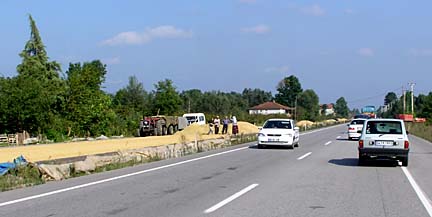 Leaving Sinop, we entered the coastal area that is less mountainous than what we had been traveling through, allowing us to make better time on the road. Here we saw wide sweeping beaches and many more settlements. This is a fertile region and obviously a great hazelnut-growing area as we were there in time to see the results of the harvest. Huge mounds of hazelnuts were left to dry on the side of the road, with farmers diligently spreading and turning the nuts throughout the day (photo above, right). Hazelnut processing plants appeared every few kilometers along the highway and trucks full of the nuts sped down the road. There were also many tobacco-drying racks lining the highway and truckloads of fresh red peppers accompanied us along our journey. Leaving Sinop, we entered the coastal area that is less mountainous than what we had been traveling through, allowing us to make better time on the road. Here we saw wide sweeping beaches and many more settlements. This is a fertile region and obviously a great hazelnut-growing area as we were there in time to see the results of the harvest. Huge mounds of hazelnuts were left to dry on the side of the road, with farmers diligently spreading and turning the nuts throughout the day (photo above, right). Hazelnut processing plants appeared every few kilometers along the highway and trucks full of the nuts sped down the road. There were also many tobacco-drying racks lining the highway and truckloads of fresh red peppers accompanied us along our journey.
We traveled along the coast as far as Trabzon before making a detour southward to visit the Sumela Monastery. This is the Greek Orthodox Monastery of the Virgin Mary. Founded in Byzantine times, it was established high on a mountainside deep in the forest. It was abandoned in 1923 after the creation of Turkey and the citizen exchange. While most visitors walk through the forest from the trailhead, we chose to drive up as far as we could, providing us with a shorter, 10 minute walk. The monastery is a conglomeration of buildings, with the chapel carved out of the rock face. The chapel itself is the highlight of the visit as its interior and exterior are covered with amazing frescoes (photo below left). The earliest ones date from the 9th century, but most are from the 19th century. Unfortunately, many have been scarred by visitors leaving their mark.
Back at the coast, we continued eastward through Rize at the heart of the tea-plantation area. Here the hills rise again from the shore and all are covered with acres and acres of tea (photo, above right). The hillsides are solid green with plantations, broken only by an occasional house (usually a big, expensive house). This area is much more humid, which probably is good for tea growing. The tea processing plants emit an overwhelming scent which to us seemed a mixture of tea and fresh-cut grass.
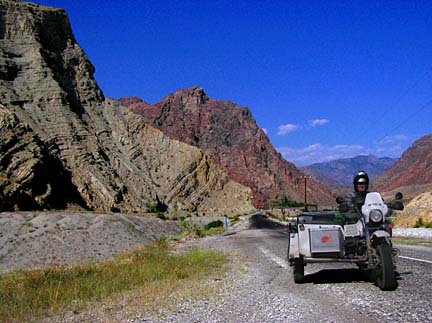 From the coast we headed south and immediately the landscape changed into an arid, mountainous region. As the landscape is mostly vertical, the roads stay on the valley floor by the river for the most part (photo, left). The one exception was the area where they were building a new hydroelectric dam. There, the road was built high on the mountainside until it was past the dam site, then once again it dropped to follow the rivers. We followed the river road to Yusufeli, a center for white-water rafting. Here we had a nice conversation with some local children, some of whom spoke surprisingly good English. In this area, Yusufeli was one of the very few communities that boasted a hotel or two, which is why we stayed there. From the coast we headed south and immediately the landscape changed into an arid, mountainous region. As the landscape is mostly vertical, the roads stay on the valley floor by the river for the most part (photo, left). The one exception was the area where they were building a new hydroelectric dam. There, the road was built high on the mountainside until it was past the dam site, then once again it dropped to follow the rivers. We followed the river road to Yusufeli, a center for white-water rafting. Here we had a nice conversation with some local children, some of whom spoke surprisingly good English. In this area, Yusufeli was one of the very few communities that boasted a hotel or two, which is why we stayed there.
The landscape remained majestic, barren, and hostile until we got further east. There it began to level out and supported some farming. We stopped along the way at the deserted Georgian church of Bana in the middle of seemingly nowhere (photo, below right). The ruins are not much more than a few archways and a mound of rubble, but it was intriguing to think what it once must have been like. The site and location are captivating. Being out here was a nice opportunity to explore some dirt roads on the sidecar and Jim had a great time maneuvering along the rutted track.
O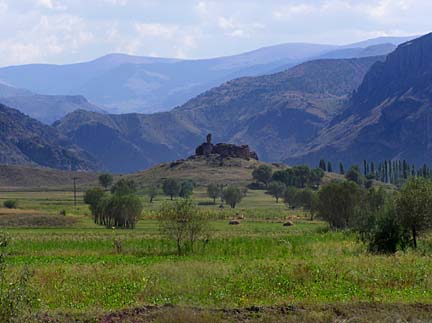 ut in this northeast corner of the country, living is hard and generally off the land. But the landscape is expansive and beautiful in its own way. The people do not have much in terms of personal possessions, but they are friendly and helpful, even if we don’t speak the same language. We stopped in the small town of Gole for lunch. We didn’t expect much out here, but found a nice small restaurant where we got a delicious and filling meal. Since we couldn’t order verbally, we went up to the kitchen and pointed out what we wanted. The restaurant was divided, with the main area only men at simple tables. A small side area with tablecloths on the tables was where the women and mixed company were seated. Outside, we were inundated with questions, but as soon as we entered the restaurant, both we and the bike were left alone. ut in this northeast corner of the country, living is hard and generally off the land. But the landscape is expansive and beautiful in its own way. The people do not have much in terms of personal possessions, but they are friendly and helpful, even if we don’t speak the same language. We stopped in the small town of Gole for lunch. We didn’t expect much out here, but found a nice small restaurant where we got a delicious and filling meal. Since we couldn’t order verbally, we went up to the kitchen and pointed out what we wanted. The restaurant was divided, with the main area only men at simple tables. A small side area with tablecloths on the tables was where the women and mixed company were seated. Outside, we were inundated with questions, but as soon as we entered the restaurant, both we and the bike were left alone.
We were intently enjoying our time here when it all too suddenly came to an end with our accident on the main highway just outside of Gole. But that is another story, better told by the Travelogue of Turkey.
|

 We began our journey in Turkey in the north, arriving from northern Greece in September, 2005. This northwestern corner of Turkey is part of the European continent, rather flat in contour, and few cities of notable mention. We drove toward Istanbul and by late afternoon (in the evening traffic rush) crossed the Bosphorus Straights and had arrived on the continent of Asia. We decided to pass through Istanbul for now, saving our visit there for the return journey. The photo above is just after we finished border formalities and added the Turkey flag. Jim is putting in his earplugs in preparation for our journey.
We began our journey in Turkey in the north, arriving from northern Greece in September, 2005. This northwestern corner of Turkey is part of the European continent, rather flat in contour, and few cities of notable mention. We drove toward Istanbul and by late afternoon (in the evening traffic rush) crossed the Bosphorus Straights and had arrived on the continent of Asia. We decided to pass through Istanbul for now, saving our visit there for the return journey. The photo above is just after we finished border formalities and added the Turkey flag. Jim is putting in his earplugs in preparation for our journey.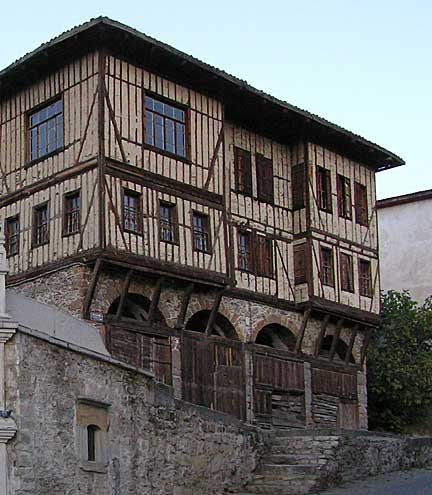
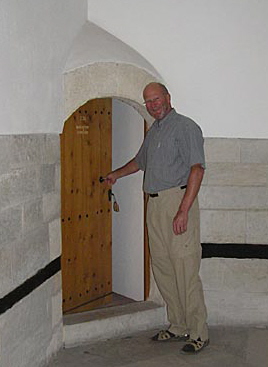
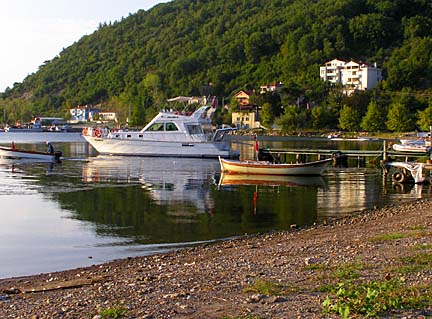
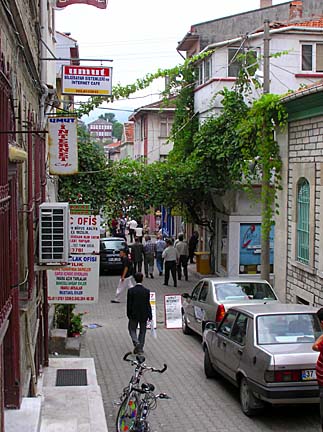
 Continuing our journey along the Black Sea, we made a stop at Sinop, a port city since the 8th century. Enjoying our seaside lunch of bluefish and a salad, we decided to stay the night and wander a bit. Probably the most notable site is the ruins of the fortress walls that once protected the port (photo left, the structure covered with green ivy is the wall). Although extended over the centuries, the existing walls were originally developed in 72 BC. The waterside along the port is home to many fishing vessels and a significant portion is park like and supports many restaurants serving up the local fish. As we looked for a hotel, we carefully surveyed the surroundings, looking for the ubiquitous minaret of the local mosque (we learned by now to not stay in the hotel next to the mosque if you didn’t want the 5:30 am wake-up call). Not seeing one, we checked into a hotel that offered decent parking (on-street, but not a busy area). We got up to our room (not on the street-side) and opened the window to gaze out to the port and found, yes, the minaret right next door. Foiled again! However, in this day and age with the loudspeakers on the minarets, it really doesn’t matter how close or far you are, you are always within earshot. We also went shopping to find Jim a new T-shirt and found a store that specialized in seconds from the booming Turkish textile industry. For about $2 we got a great shirt whose only visible defect was an off-centered decal.
Continuing our journey along the Black Sea, we made a stop at Sinop, a port city since the 8th century. Enjoying our seaside lunch of bluefish and a salad, we decided to stay the night and wander a bit. Probably the most notable site is the ruins of the fortress walls that once protected the port (photo left, the structure covered with green ivy is the wall). Although extended over the centuries, the existing walls were originally developed in 72 BC. The waterside along the port is home to many fishing vessels and a significant portion is park like and supports many restaurants serving up the local fish. As we looked for a hotel, we carefully surveyed the surroundings, looking for the ubiquitous minaret of the local mosque (we learned by now to not stay in the hotel next to the mosque if you didn’t want the 5:30 am wake-up call). Not seeing one, we checked into a hotel that offered decent parking (on-street, but not a busy area). We got up to our room (not on the street-side) and opened the window to gaze out to the port and found, yes, the minaret right next door. Foiled again! However, in this day and age with the loudspeakers on the minarets, it really doesn’t matter how close or far you are, you are always within earshot. We also went shopping to find Jim a new T-shirt and found a store that specialized in seconds from the booming Turkish textile industry. For about $2 we got a great shirt whose only visible defect was an off-centered decal. Leaving Sinop, we entered the coastal area that is less mountainous than what we had been traveling through, allowing us to make better time on the road. Here we saw wide sweeping beaches and many more settlements. This is a fertile region and obviously a great hazelnut-growing area as we were there in time to see the results of the harvest. Huge mounds of hazelnuts were left to dry on the side of the road, with farmers diligently spreading and turning the nuts throughout the day (photo above, right). Hazelnut processing plants appeared every few kilometers along the highway and trucks full of the nuts sped down the road. There were also many tobacco-drying racks lining the highway and truckloads of fresh red peppers accompanied us along our journey.
Leaving Sinop, we entered the coastal area that is less mountainous than what we had been traveling through, allowing us to make better time on the road. Here we saw wide sweeping beaches and many more settlements. This is a fertile region and obviously a great hazelnut-growing area as we were there in time to see the results of the harvest. Huge mounds of hazelnuts were left to dry on the side of the road, with farmers diligently spreading and turning the nuts throughout the day (photo above, right). Hazelnut processing plants appeared every few kilometers along the highway and trucks full of the nuts sped down the road. There were also many tobacco-drying racks lining the highway and truckloads of fresh red peppers accompanied us along our journey.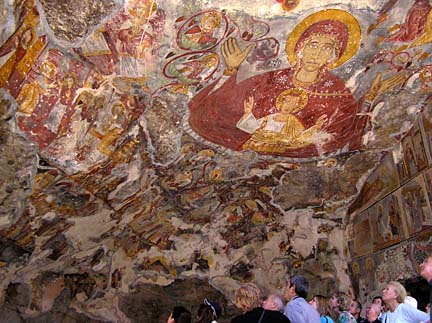
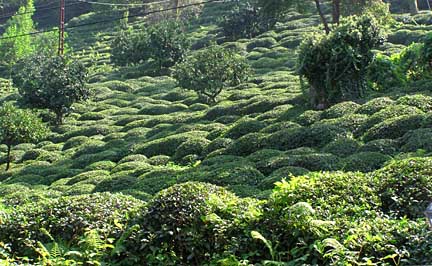
 From the coast we headed south and immediately the landscape changed into an arid, mountainous region. As the landscape is mostly vertical, the roads stay on the valley floor by the river for the most part (photo, left). The one exception was the area where they were building a new hydroelectric dam. There, the road was built high on the mountainside until it was past the dam site, then once again it dropped to follow the rivers. We followed the river road to Yusufeli, a center for white-water rafting. Here we had a nice conversation with some local children, some of whom spoke surprisingly good English. In this area, Yusufeli was one of the very few communities that boasted a hotel or two, which is why we stayed there.
From the coast we headed south and immediately the landscape changed into an arid, mountainous region. As the landscape is mostly vertical, the roads stay on the valley floor by the river for the most part (photo, left). The one exception was the area where they were building a new hydroelectric dam. There, the road was built high on the mountainside until it was past the dam site, then once again it dropped to follow the rivers. We followed the river road to Yusufeli, a center for white-water rafting. Here we had a nice conversation with some local children, some of whom spoke surprisingly good English. In this area, Yusufeli was one of the very few communities that boasted a hotel or two, which is why we stayed there.  ut in this northeast corner of the country, living is hard and generally off the land. But the landscape is expansive and beautiful in its own way. The people do not have much in terms of personal possessions, but they are friendly and helpful, even if we don’t speak the same language. We stopped in the small town of Gole for lunch. We didn’t expect much out here, but found a nice small restaurant where we got a delicious and filling meal. Since we couldn’t order verbally, we went up to the kitchen and pointed out what we wanted. The restaurant was divided, with the main area only men at simple tables. A small side area with tablecloths on the tables was where the women and mixed company were seated. Outside, we were inundated with questions, but as soon as we entered the restaurant, both we and the bike were left alone.
ut in this northeast corner of the country, living is hard and generally off the land. But the landscape is expansive and beautiful in its own way. The people do not have much in terms of personal possessions, but they are friendly and helpful, even if we don’t speak the same language. We stopped in the small town of Gole for lunch. We didn’t expect much out here, but found a nice small restaurant where we got a delicious and filling meal. Since we couldn’t order verbally, we went up to the kitchen and pointed out what we wanted. The restaurant was divided, with the main area only men at simple tables. A small side area with tablecloths on the tables was where the women and mixed company were seated. Outside, we were inundated with questions, but as soon as we entered the restaurant, both we and the bike were left alone.